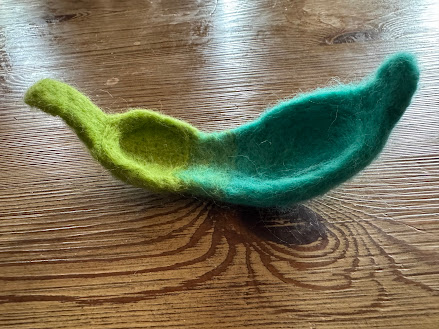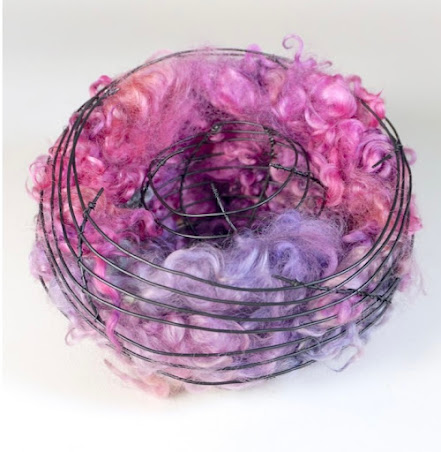July 2
Self-Assessment Questions
Artist Influence
Which artist did I draw inspiration from for this piece, and how did I interpret their techniques, themes, or forms in a way that feels unique to my own practice?I drew inspiration from two fiber artists, Andrea Graham and Gillian Chapman. Graham’s bold, textured sculptures fascinated me because they seem like they could exist in nature, even though they clearly don’t. Her pieces balance between familiar and otherworldly that I wanted to bring into my own work. Chapman’s Seeds & Pods series showed me how textile art can suggest growth, evolution, and transformation without directly imitating actual plants. From both artists, I learned how fiber can embody the idea of life cycles and metamorphosis. I carried these influences into my imagined life forms that are part seed, part cocoon, maybe even part creature. I gave them personality and energy through form and color.
Technical Growth
What new techniques or materials did I explore in this sculpture? How did I push beyond what I already knew, and where do I see evidence of growth in my craftsmanship?This was my first time sculpting an entire form using only felt, without relying on a styrofoam base. That was a big shift for me, and I think it pushed my skills quite a bit. I used thin layers of felt to build shape and volume, learning how to create depth and roundness through careful layering and shaping. It was challenging at times, especially when the form wasn’t matching the sketch exactly, but I adjusted as I went. I also explored adding openings and more abstract features to suggest movement and life. Looking back, I see growth in how confidently I handled the medium especially in shaping and firming the structure.
Material Relationship
How did I balance fiber with any other materials I incorporated? Did I consider texture, weight, and structure in how these materials interact?This piece is made entirely from felt, so the relationship between fiber and form became really important. I paid a lot of attention to how the texture and softness of the felt could enhance the organic and otherworldly feel I wanted. I used contrasting colors and varying thicknesses to emphasize certain features and suggest natural transformation. Even though I didn’t end up adding other materials, I considered texture, weight, and structure at every stage especially in making sure the piece held its shape while still feeling soft and alive.
Conceptual Development
What idea, feeling, or narrative am I communicating with this work? How clearly does the sculpture reflect that intention?The main idea behind this piece was transformation, like a life form evolving or coming into being. However, due to the time limit, I decided to only create the last stage, the green and turquoise pod. I imagined this piece as a kind of alien plant or cocoon, something suspended between natural and imagined worlds. The final sculpture includes an additional side opening and an inner space, which I think really supports that idea. I also made sure to keep the waft of felt in the bottom hole of the pod. I knew this slight addition would definitely make my piece feel alive. This piece may not tell a literal story yet, but I think the abstract, surreal quality invites viewers to interpret their own meaning, which feels true to the concept I had in mind.
Craft and Detail
Did I demonstrate care in construction and finishing details? Did I include a complete color inventory and think intentionally about scale, stability, and presentation?I feel really proud of the care I put into constructing this piece. Even though I had to cut a few elements, like the purple spots and possible seed due to time constraints, I made sure that the details I did include were thoughtful and well executed. I chose a color palette that was vibrant and intentional, pulled from my sketch and materials I sourced myself. The transition from green to turquoise is carefully placed and is true to the original sketch. I also paid attention to scale and form stability, especially as I shaped the upper stem and reinforced weak areas. Overall, I think the craftsmanship shows my attention to both design and detail.
June 30
Final Piece!
June 29
I am nearly done with the plant/cocoon now, the base is done. While finishing the base form, I added a hole in the side to add to the abstract and alien feel. I don’t think I am going to add the purple spots to my piece due to time limitations. However, I am going to add the wispy felt to the bottom hole and possibly in the smaller hole. I also want to fix the upper stem portion by making it thicker because it still feels flat. I haven’t used only felt to create the shape before, so I think it's looking really alive. When I first did felt I used a styrofoam base and added felt to that. Overall, I really enjoy how this piece is turning out.
June 22
Here is the first update on my naturalistic/abstract subject. I like to think of this creation as an alien plant/cocoon. So far, I have gotten a nice base shape and the form is firm. I have been layering thin wafts of felt to create the form. This has been creating the depth and roundness I want in my pod. The form is a tad off from my sketch but I do plan on filling out the green portion and turquoise parts. After I fill out the pod shape I plan on adding purple spots like designed in the sketch. I also may create a seed to go inside either the green portion or the blue depending on the time it takes to create the main form.
June 16
After our first discussion and some in depth research, I knew I wanted to start with something rooted in nature, but also have an abstract feel. I was drawn to the idea of working with organic shapes, something that felt alive and maybe even a little strange. I have always strived to create pieces that feel and look unique. When I came across the work of Andrea Graham, I started to get inspired. Her sculptures are very bold and textured, and they somehow feel like they could exist in nature, even though they clearly don’t. That balance between familiar and otherworldly really stuck with me. I was also inspired by Gillian Chapman, her Seeds & Pods series showed me how textile art can suggest growth, evolution, and organic transformation without directly mimicking the natural world. Both artists helped me see how fiber can embody themes of life cycles and metamorphosis.
So, I started sketching and playing with forms that felt like pods or vessels, things that could be growing or transforming. I ended up designing three different kinds of pods, each with its own personality. The yellow pod is how this cocoon starts off. Then it transitions into the blue and orange and finally finishes as a completely open pod. I imagined these as abstract life forms, part seed, creature, and cocoon. They're not meant to be realistic, but they’re definitely meant to feel alive in some aspect.
Color became a huge part of the process too. I went to Hobby Lobby in search of felt and found a pack of bright and vibrant colors. Personally, I enjoy using lively colors in my pieces to make them stand out and look unique. The contrast between the colors that I use in my sketch helps emphasize the shapes and textures, and I think it gives them a sense of movement or energy, even when they’re still.
I also thought a lot about how these forms would be displayed. I couldn’t decide whether to make one large, grounded piece or several smaller ones that hang from above. The hanging pods feel delicate, almost like specimens or suspended creatures/plants. But the idea of one large pod has more weight and presence. I’m still figuring that part out, but both options help express themes of growth, mystery, and transformation.
Overall, this piece became a way for me to explore organic forms with a surreal twist, something that feels like it belongs in nature, even if it’s imagined.
ARTIST INSPIRATION: Andrea Graham ~ https://livingfelt.wordpress.com/2012/04/20/3648/

















































